Question 1.
In which of the following situations, does the list of numbers involved make an arithmetic progression, and why?
i) The taxi fare after each km when the fare is Rs. 20 for the first km and rises by Rs. 8 for each additional km.
Answer:
Fare for the first km = Rs. 20 = a
Fare for each km after the first = Rs. 8 = d
∴ The fares would be 20, 28, 36, 44, …….
The above list forms an A.P.
Since each term in the list, starting from the second can be obtained by adding ‘8’ to its preceding term.
ii) The amount of air present in a cylinder when a vacuum pump removes 1/4 th of the air remaining in the cylinder at a time.
Answer:
Let the amount of air initially present in the cylinder be 1024 lit.
First it removes 1/4 th of the volume
i.e., 1/4 × 1024 = 256
∴ Remaining air present in the cylinder = 768
At second time it removes 1/4 th of 768
i.e., 1/4 × 768 = 192
∴ Remaining air in the cylinder = 768 - 192 = 576
Again at third time it removes 1/4 th of 576
i.e., 1/4 × 576 = 144
Remaining air in the cylinder = 576 - 144 = 432
i.e., the volume of the air present in the cylinder after 1st, 2nd, 3rd,… times is 1024, 768, 576, 432, …..
Here, a2- a1= 768 - 1024 = - 256
a3- a2= 576 - 768 = - 192
a4- a3= 432 - 576 = - 144 .
Thus the difference between any two successive terms is not equal to a fixed number.
∴ The given situation doesn’t show an A.P.
iii) The cost of digging a well, after, every metre of digging, when it costs ? 150 for the first metre and rises by ? 50 for each subsequent metre.
Answer:
Cost for digging the first metre = Rs. 150
Cost for digging subsequent metres = Rs. 50 each.
i.e.,

The list is 150, 200, 250, 300, 350, ……..
Here d = a2- a1= a3- a2= a4- a3= ……. = 50
∴ The given situation represents an A.P.
iv) The amount of money in the account every year, when Rs. 10000 is deposited at compound interest at 8 % per annum.
Answer:
Amount deposited initially = P = Rs. 10,000
Rate of interest = R = 8% p.a [at C.I.]
∴ A=P(1+R/100)n
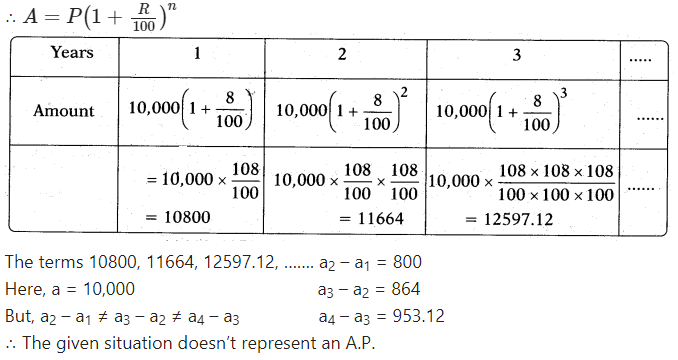
The terms 10800, 11664, 12597.12, ……. a2 -a1= 800
Here, a = 10,000 a3- a2= 864
But, a2- a1≠ a3 - a2≠ a4 - a3 a4 a3= 953.12
∴ The given situation doesn’t represent an A.P.
Question 2.
Write first four terms of the AP, when the first term a and the common difference d are given as follows:
i) a = 10, d = 10
ii) a = -2, d = 0
iii) a = 4, d = - 3
iv) a = - 1, d = 1/2
v) a = - 1.25, d = - 0.25
Answer:
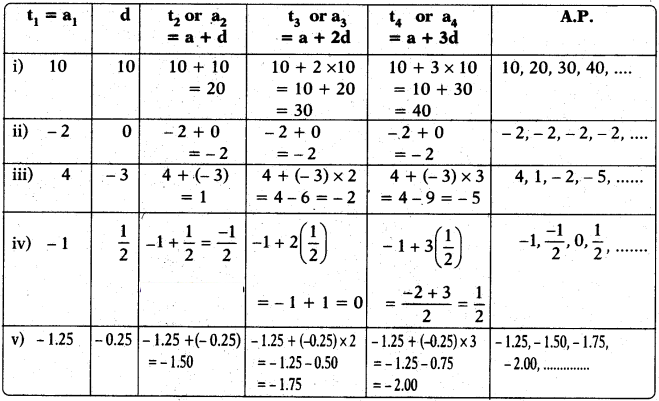
Question 3.
For the following A.Ps, write the first term and the common difference:
i) 3, 1, - 1, - 3,….
ii) - 5, - 1, 3, 7,….
iii)1/3, 5/3, 9/3, 13/3, ……..
iv) 0.6, 1.7, 2.8, 3.9,…
Answer:
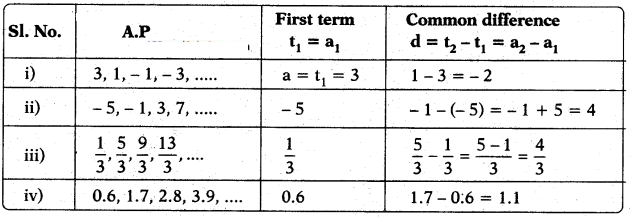
Question 4.
Which of the following are APs ? If they form an AP, find the common difference d and write three more terms.
i) 2, 4, 8, 16, ...
ii) 2, 5/2, 3, 7/2, ...
iii) - 1.2, - 3.2, - 5.2, - 7.2,..
iv) -10,-6, -2, 2, ...
v) 3, 3 + √2, 3 + 2√2, 3 + 3√2, ...
vi) 0.2, 0.22, 0.222, 0.2222, ..
vii) 0, -4, -8, -12, ...
viii) - 1/2, - 1/2, - 1/2, - 1/2
ix) 1, 3, 9, 27,...
x) a, 2a, 3a, 4a,..
xi) a, a2, a3, a4, ...
xii) √2, √8, √18, √32, ...
xiii) √3, √6, √9, √12, ...
Answer:
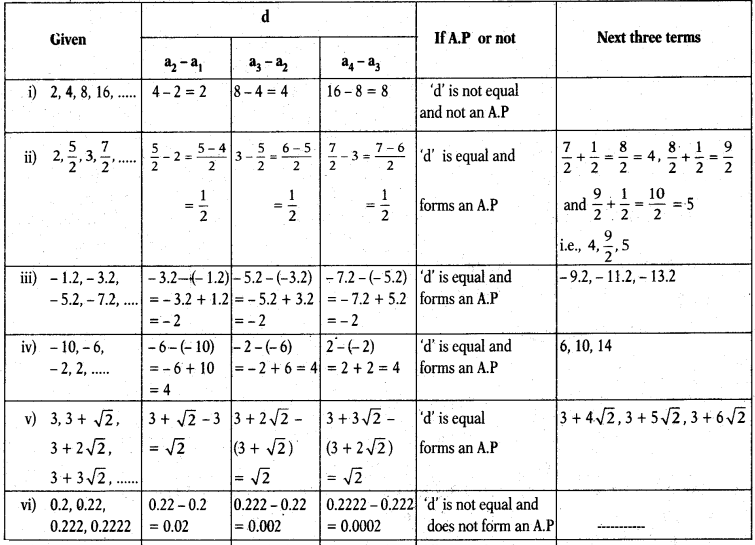
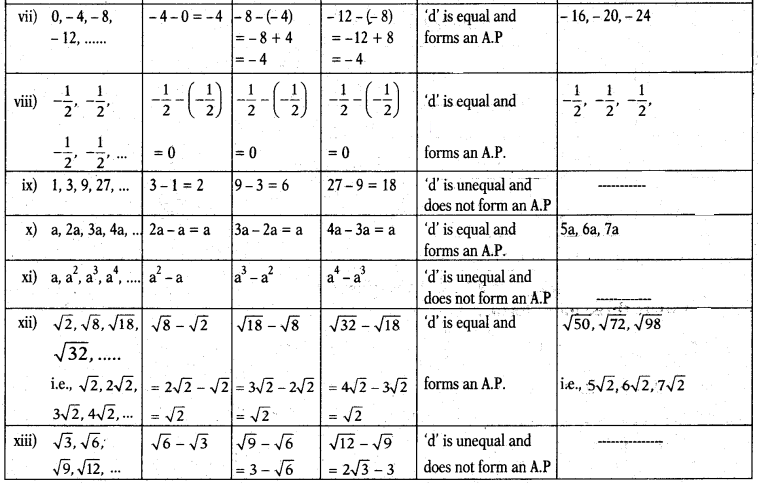
Question 1.
Fill in the blanks in the following table, given that ‘a’ is the first term, d the common difference and an the nth term of the A.P:
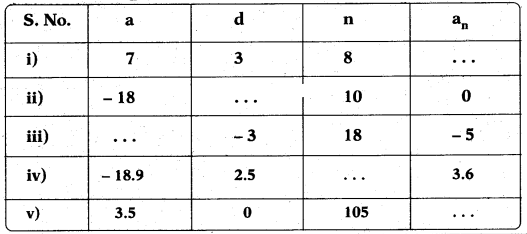
Answer:
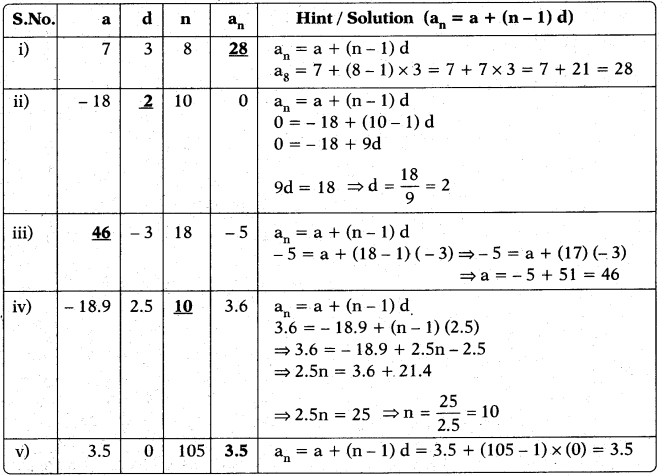
Question 2.
Find the i) 30th term of the A.P.: 10, 7, 4,……
ii) 11th term of the A.P.: -3, -1/2, 2,…
Answer:
i) Given A.P. = 10, 7, 4, …….
a1= 10; d = a2- a1= 7 - 10 = - 3
an= a + (n - 1) d
a30= 10 + (30 - 1) (- 3) = 10 + 29 × (- 3) = 10 - 87 = - 77
ii) Given A.P. = - 3, - 1/2, 2,.
a1 = -3; d = a2 - a1 = - 1/2 - (-3) = - 3
= -12 + 3
= -1+62
= 52
an = a + (n - 1) d
= -3 + (11-1) × 5/2
= -3 + 10 × 5/2
= -3 + 5 × 5
= -3 + 25
= 22
Question 3.
Find the respective terms for the following APs.
i) a1 = 2; a3 = 26, find a2.
Answer:
Given: a1 = a = 2 .... (1)
a3 = a + 2d = 26 .... (2
Equation (2) - equation (1)
⇒ (a + 2d) - a = 26 - 2
⇒ 2d = 24
d = 24/2 = 12
Now a2 = a + d = 2 + 12 = 14
ii) a2 = 13; a4 = 3, find a1, a3.
Answer:
Given: a2 = a + d = 13 ... (1)
a4 = a + 3d = 3 ... (2)
Solving equations (1) and (2);

∴ Substituting d = - 5 in equation (1) we get
a + (-5) = 13
∴ a = 13 + 5 = 18 i.e., a1 = 18
a3 = a + 2d = 18 + 2(- 5)
= 18 - 10 = 8
iii) a1= 5; a4= 9 1/2, find a2, a3.
Answer:
Given: a1= a = 5 ….. (1)
a4= a + 3d = 9 1/2 ….. (2)
Solving equations (1) and (2);
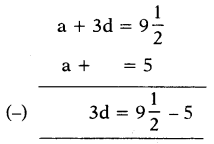
⇒ 3d = 4 1/2
⇒ 3d = 9/2
⇒ d = 9/2×3 =3/2
∴ a2= a + d = 5 +3/2=13/2
a3= a + 2d = 5 + 2 × 3/2 = 5 + 3 = 8
iv) a1= -4; a6= 6, find a2, a3, a4, a5.
Answer:
Given: a1= a = -4 ….. (1)
a6= a + 5d = 6 ….. (2)
Solving equations (1) and (2);
(-4) + 5d = 6
⇒ 5d = 6 + 4
⇒ 5d = 10
⇒ d =105
Now
∴ a2= a + d = -4 + 2 = -2
a3= a + 2d = -4 + 2 × 2 = -4 + 4 = 0
a4= a + 3d = -4 + 3 × 2 = -4 + 6 = 2
a5= a + 4d = -4 + 4 × 2 = -4 + 8 = 4
v) a2= 38; a6= -22, find a1, a3, a4, a5.
Answer:
Given: a2= a + d = 38 ….. (1)
a6= a + 5d = -22 ….. (2)
Subtracting (2) from (1) we get
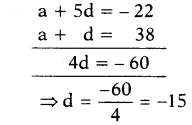
Now substituting, d = - 15 in equation (1), we get
a + (- 15) = 38 ⇒ a = 38 + 15 = 53
Thus,
a1= a = 53;
a3= a + 2d = 53 + 2 × (- 15) = 53 - 30 = 23;
a4= a + 3d = 53 + 3 × (- 15) = 53 - 45 = 8;
a5= a + 4d = 53 + 4 × (- 15) = 53 - 60 = - 7
Question 4.
Which term of the AP:
3, 8, 13, 18,…, is 78?
Answer:
Given: 3, 8, 13, 18, ……
Here a = 3; d = a2- a1= 8 - 3 = 5
Let ‘78’ be the nth term of the given A.P.
∴ an= a + (n - 1) d
⇒ 78 = 3 + (n - 1) 5
⇒ 78 = 3 + 5n - 5
⇒ 5n = 78 + 2
⇒ n =80/2= 16
∴ 78 is the 16th term of the given A.P.
Question 5.
Find the number of terms in each of the following APs:
i) 7, 13, 19, ….., 205
Answer:
Given: A.P: 7, 13, 19, ……….
Here a1= a = 7; d = a2- a1= 13 - 7 = 6
Let 205 be the nthterm of the given A.P.
Then, an= a + (n - 1) d
205 = 7 + (n - 1)6
⇒ 205 = 7 + 6n - 6
⇒ 205 = 6n + 1
⇒ 6n = 205 - 1 = 204
∴ n =204/6= 34
∴ 34 terms are there.
ii) 18, 15 1/2, 13, ………, -47
Answer:
Given: A.P: 18, 15 1/2, 13, ………
Here a1 = a = 18;
d = a2 - a1 = 15 1/2 - 18 = -2 1/2 = - 5/2
Let ‘-47’ be the nth term of the given A.P.
an = a + (n - 1) d
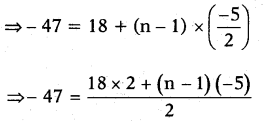
⇒ -94 = 36 - 5n + 5
⇒ 5n = 94 + 41
⇒ n = 135/5 = 27
∴ 27 terms are there.
Question 6.
Check whether, -150 is a term of the AP: 11, 8, 5, 2…
Answer:
Given: A.P. = 11, 8, 5, 2…
Here a1= a = 11;
d = a2- a1= 8 - 11 = -3
If possible, take - 150 as the nthterm of the given A.P.
an= a + (n - 1) d
⇒ -150 = 11 + (n - 1) × (-3)
⇒ -150 = 11 - 3n + 3
⇒ 14 - 3n = - 150
⇒ 3n= 14 + 150 = 164
∴ n =164/3= 54 2/3
Here n is not an integer.
∴ -150 is not a term of the given A.P.
Question 7.
Find the 31stterm of an A.P. whose 11thterm is 38 and the 16thterm is 73.
Answer:
Given: An A.P. whose

⇒ -5d = -35
⇒ d = -35/-5 = 7
Substituting d = 7 in the equation (1)
we get,
a + 10 x 7 = 38
⇒ a + 70 = 38
⇒ a = 38 - 70 = -32
Now, the 31st term = a + 30d
= (-32) + 30 × 7
= -32 + 210 = 178
Question 8.
If the 3rd and the 9thterms of an A.P are 4 and -8 respectively, which term of this A.P is zero?
Answer:
Given: An A.P. whose
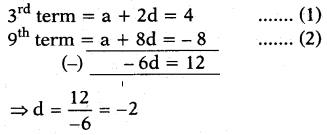
Substituting d = -2 in equation (1) we get
a + 2 × (-2) = 4
⇒ a - 4 = 4
⇒ a = 4 + 4 = 8
Let nth term of the given A.P be equal to zero.
an = a + (n - 1)d
⇒ 0 = 8 + (n - 1) × (-2)
⇒ 0 = 8 - 2n + 2
⇒ 10 - 2n = 0
⇒ 2n = 10 and n = 10/2 = 5
∴ The 5th term of the given A.P is zero.
Question 9.
The 17th term of an A.P exceeds its 10 term by 7. Find the common difference.
Answer:
Given an A.P in which a17= a10+ 7
⇒ a17- a10= 7
We know that an= a + (n - 1)d
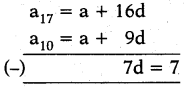
⇒ d = 7/7 = 1
Question 10.
Two APs have the same common difference. The difference between their 100thterms is 100, what is the difference between their 1000thterms?
Answer:
Let the first A.P be:
a, a + d, a + 2d, ……..
Second A.P be:
b, b + d, b + 2d, b + 3d, ………
Also, general term, an= a + (n - 1)d
Given that, a100- b100= 100
⇒ a + 99d - (b + 99d) = 100
⇒ a - b = 100
Now the difference between their 1000thterms,

∴ The difference between their 1000th terms is (a - b) = 100.
Note: If the common difference for any two A.Ps are equal then difference between nthterms of two A.Ps is same for all natural values of n.
Question 11.
How many three-digit numbers are divisible by 7?
Answer:
The least three digit number is 100.
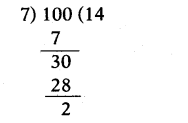
∴ The least 3 digit number divisible by 7 is 100 + (7 - 2) = 105
The greatest 3 digit number is 999
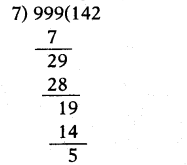
∴ The greatest 3 digit number divisible by 7 is 999 - 5 = 994.
∴ 3 digit numbers divisible by 7 are
105, 112, 119,….., 994.
a1= a = 105; d = 7; an= 994
an= a + (n - 1)d
⇒ 994 = 105 + (n - 1)7
⇒ (n - 1)7 = 994 - 105
⇒ (n - 1)7 = 889
⇒ n - 1 = 889/7 = 127
∴ n = 127 + 1 = 128
∴ There are 128, 3 digit numbers which are divisible by 7.
(or)
last number - first number/7
999-100/7
≃ 128.4 = 128 numbers divisible by 7.
Question 12.
How many multiples of 4 lie between 10 and 250?
Answer:
Given numbers: 10 to 250
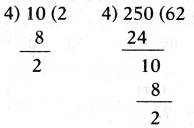
∴ Multiples of 4 between 10 and 250 are
First term: 10 + (4 - 2) = 12
Last term: 250 - 2 = 248
∴ 12, 16, 20, 24, ….., 248
a = a1= 12; d = 4; an= 248
an= a + (n - 1)d
248 = 12 + (n - 1) × 4
⇒ (n - 1)4 = 248 - 12
⇒ n - 1 =236/4= 59
∴ n = 59 + 1 = 60
There are 60 numbers between 10 and 250 which are divisible by 4.
Question 13.
For what value of n, are the nthterms of two APs: 63, 65, 67, ….. and 3, 10, 17,… equal?
Answer:
Given : The first A.P. is 63, 65, 67, ……
where a = 63, d = a2- a1,
⇒ d = 65 - 63 = 2
and the second A.P. is 3, 10, 17, …….
where a = 3; d = a2- a1= 10 - 3 = 7
Suppose the nth terms of the two A.Ps are equal, where an= a + (n - 1)d
⇒ 63 + (n - 1)2 = 3 + (n - 1)7
⇒ 63 + 2n - 2 = 3 + 7n - 7
⇒ 61 + 2n = 7n - 4
⇒ 7n - 2n = 61 + 4
⇒ 5n = 65
⇒ n =65/5= 13
∴ 13thterms of the two A.Ps are equal.
Question 14.
Determine the AP whose third term is 16 and the 7thterm exceeds the 5thterm by 12.
Answer:
Given : An A.P in which
a3= a + 2d = 16 …… (1)
and a7= a5+ 12
i.e., a + 6d = a + 4d + 12
⇒ 6d - 4d = 12
⇒ 2d = 12
⇒ d =12/2= 6
Substituting d = 6 in equation (1) we get
a + 2 × 6 = 16
⇒ a = 16 - 12 = 4
∴ The series/A.P is
a, a + d, a + 2d, a + 3d, …….
⇒ 4, 4 + 6, 4 + 12, 4 + 18, ……
⇒ A.P.: 4, 10, 16, 22, …….
Question 15.
Find the 20thterm from the end of the AP: 3, 8, 13,…, 253.
Answer:
Given: An A.P: 3, 8, 13, …… , 253
Here a = a1= 3
d = a2- a1= 8 - 3 = 5
an= 253, where 253 is the last term
an= a + (n - l)d
∴ 253 = 3 + (n - 1)5
⇒ 253 = 3 + 5n - 5
⇒ 5n = 253 + 2
⇒ n =2555= 51
∴ The 20thterm from the other end would be
1 + (51 - 20) = 31 + 1 = 32
∴ a32= 3 + (32 - 1) × 5
= 3 + 31 × 5
= 3 + 155 = 158
Question 16.
The sum of the 4thand 8thterms of an AP is 24 and the sum of the 6thand 10thterms is 44. Find the first three terms of the AP.
Answer:
Given an A.P in which a4+ a8= 24
⇒ a + 3d + a + 7d = 24
⇒ 2a + 10d = 24
⇒ a + 5d = 12 ……. (1)
and a6+ a10= 44
⇒ a + 5d + a + 9d = 44
⇒ 2a + 14d = 44
⇒ a + 7d = 22 ……. (2)
Also a + 5d = 12
⇒ a + 5(5) = 12
⇒ a + 25 = 12
⇒ a = 12 - 25 = -13
∴ The A.P is a, a + d, a + 2d, ……
i.e., - 13, (- 13 + 5), (-13 + 2 × 5)…
⇒ -13, -8, -3, …….
Question 17.
Subba Rao started work in 1995 at an annual salary of Rs. 5000 and received an increment of Rs. 200 each year. In which year did his income reach Rs. 7000?
Answer:
Given: Salary of Subba Rao in 1995 = Rs. 5000
Annual increment = Rs. 200
i.e., His salary increases by Rs. 200 every year.
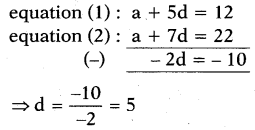
Clearly 5000, 5200, 5400, forms an A.P in which a = 5000 and d = 200.
Now suppose that his salary reached Rs. 7000 after x - years.
i.e., an= 7000
But, an= a + (n - 1)d
7000 = 5000 + (n - 1)200
⇒ 7000 - 5000 = (n - 1)200
⇒ n - 1 =2000200= 10
⇒ n = 10 + 1
∴ In 11thyear his salary reached Rs. 7000.
Question 1.
Find the sum of the following APs:
i) 2, 7, 12,…, to 10 terms.
Answer:
Given A.P: 2, 7, 12, …… to 10 terms
a = 2; d = a2- a1= 7 - 2 = 5; n = 10
Sn=n/2[2a + (n - 1)d]
∴ S10=10/2[2 × 2 + (10 - 1)5]
= 5 [4 + 9 × 5]
= 5 [4 + 45]
= 5 × 49
= 245
ii) -37, -33, -29,…, to 12 terms.
Answer:
Given A.P: -37, -33, -29,…, to 12 terms.
a = -37; d = a2- a1= (-33) - (-37) = -33 + 37 = 4; n = 12
Sn=n/2[2a + (n - 1)d]
∴ S12=12/2[2 × (-37) + (12 - 1)4]
= 6 [-74 + 11 × 4]
= 6 [-74 + 44]
= 6 × (-30)
= -180
iii) 0.6, 1.7, 2.8,…, to 100 terms.
Answer:
Given A.P : 0.6, 1.7, 2.8,…. S100
a = 0.6; d = a2- a1= 1.7 - 0.6 = 1.1; n = 100
Sn=n/2[2a + (n - 1)d]
∴ S100=100/2[2 × 0.6 + (100 - 1)1.1]
= 50 [1.2 + 99 × 1.1]
= 50 [1.2 + 108.9]
= 50 × 110.1
= 5505
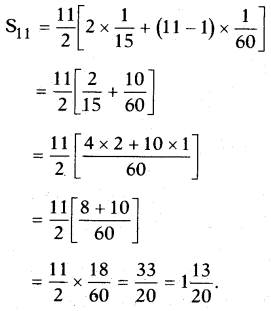
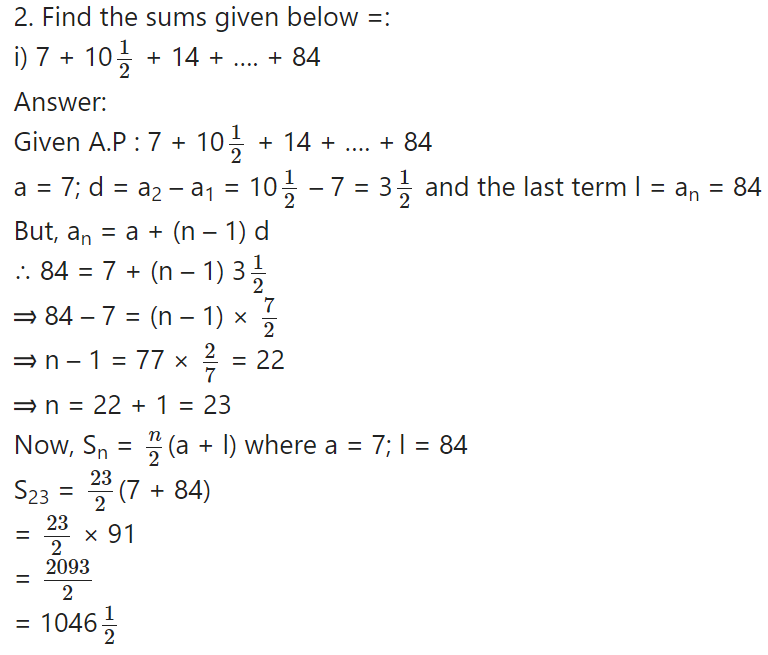
ii) 34 + 32 + 30 + … + 10
Answer:
Given A.P: 34 + 32 + 30 + … + 10
a = 34; d = a2- a1= 32 - 34 = -2 and the last term l = an= 10
But, an= a + (n - 1) d
∴ 10 = 34 + (n - 1) (-2)
⇒ 10 - 34 = -2n + 2
⇒ -2n = -24 - 2
⇒ n =-26/-2= 13
∴ n = 13
Also, Sn=n/2(a + l)
where a = 34; l = 10
S13=13/2(34 + 10)
=13/2× 44
= 13 × 22
= 286
iii) -5 + (-8) + (-11) + … + (-230)
Answer:
Given A.P: -5 + (-8) + (-11) + … + (-230)
Here first term, a = -5;
d = a2- a1= (-8) - (-5) = -8 + 5 = -3 and the last term l = an= 10
But, an= a + (n - 1) d
∴ (-230) = -5 + (n - 1) (-3)
⇒ -230 + 5 = -3n + 3
⇒ -3n + 3 = -225
⇒ -3n = -225 - 3
⇒ 3n = 228
⇒ n =228/3= 76
∴ n = 76
Now, Sn=n/2(a + l)
where a = -5; l = -230
S76=76/2((-5) + (-230))
= 38 × (-235)
= -8930
Question 3.
In an AP:
i) Given a = 5, d = 3, an= 50. find n and Sn.
Answer:
Given :
a = 5; d = 3;
an= a + (n - 1)d = 50
⇒ 50 = 5 + (n - 1) 3
⇒ 50 - 5 = 3n - 3
⇒ 3n = 45 + 3
⇒ n =48/3= 16
Now, Sn=n/2(a + l)
S16=16/2(5 + 50)
= 38 × 55
= 440
ii) Given a = 7, a13= 35, find d and S13.
Answer:
Given: a = 7;
a13= a + 12d = 35
⇒ 7 + 12d = 35
⇒ 12d = 35 - 7
⇒ n =28/12=7/3
Now, Sn=n/2(a + l)
S13=13/2(7 + 35)
=13/2 × 42
= 13 × 21
= 273
iii) Given a12= 37, d = 3 find a and S12.
Answer:
Given:
a12= a + 11d = 37
d = 3
So, a12= a + 11 × 3 = 37
⇒ a + 33 = 37
⇒ a = 37 - 33 = 4
Now, Sn=n/2(a + l)
S12=12/2(4 + 37)
= 6 × 41
= 246
iv) Given a3= 15, S10= 125, find d and a10.
Answer:
Given:
a3= a + 2d = 15
⇒ a = 15 - 2d ……… (1)
S10= 125 but take S10as 175
i.e., S10= 175
We know that,
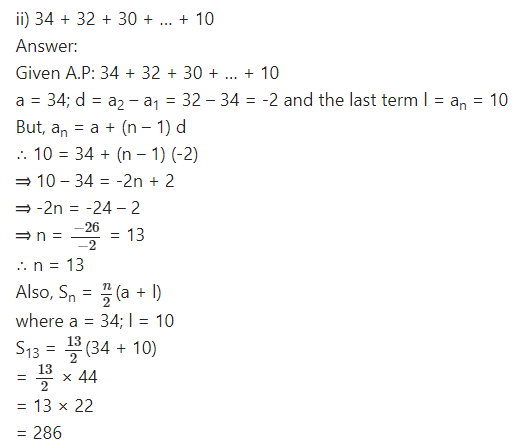
⇒ 35 = 2 (15 - 2d) + 9d [∵ a = 15 - 2d]
⇒ 35 = 30 - 4d + 9d
⇒ 35 - 30 = 5d
⇒ d =5/5= 1
Substituting d = 1 in equation (1) we get
a = 15 - 2 × 1 = 15 - 2 = 13
Now, an= a + (n - 1) d
a10= a + 9d = 13 + 9 × 1 = 13 + 9 = 22
∴ a10= 22; d = 1
v) Given a = 2, d = 8, Sn= 90, find n and an.
Answer:
Given a = 2, d = 8, Sn= 90
Sn=n/2[2a + (n - 1)d]
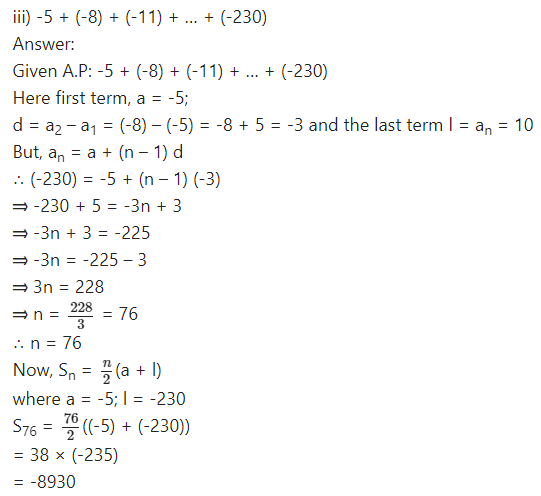
⇒ 90 = 2n [2n - 1]
⇒ 4n2- 2n = 90
⇒ 4n2- 2n - 90 = 0
⇒ 2(2n2- n - 45) = 0
⇒ 2n2- n - 45 = 0
⇒ 2n2-10n + 9n - 45 = 0
⇒ 2n(n - 5) + 9(n - 5) = 0
⇒ (n - 5)(2n + 9) = 0
⇒ n - 5 = 0 (or) 2n + 9 = 0
⇒ n = 5 (or) n =-9/2(discarded)
∴ n = 5
Now an= a5= a + 4d = 2 + 4 x 8
= 2 + 32 = 34
vi) Given an= 4, d = 2, Sn= -14, find n and a.
Answer:
Given an= a + (n - 1) d = 4 ……. (1)
d = 2; Sn= - 14
From (1); a + (n - 1) 2 = 4
a = 4 - 2n + 2
a = 6 - 2n
Given a = 2, d = 8, Sn= 90
Sn=n2[a + an]
-14 =n/2[(6-2n) + 4] [∵ a = 6 - 2n]
-14 × 2 = n (10 - 2n)
⇒ 10n - 2n2= - 28
⇒ 2n2- 10n - 28 = 0
⇒ n2- 5n - 14 = 0
⇒ n2- 7n + 2n - 14 = 0
⇒ n (n - 7) + 2 (n - 7) = 0
⇒ (n - 7) (n + 2) = 0
⇒ n = 7 (or) n = - 2
∴ n = 7
Now a = 6 - 2n = 6 - 2 × 7
= 6 - 14 = -8
∴ a = - 8; n = 7
vii) Given l = 28, S = 144, and there are total 9 terms. Find a.
Answer:
Given:
l = a9= a + 8d = 28 and S9= 144 But,
Now, Sn=n/2(a + l)
144 =9/2(a + 28)
⇒ 144 × 2/9 = a + 28
⇒ a + 28 = 32
⇒ a = 4
Question 4.
The first and the last terms of an A.P are 17 and 350 respectively. If the common difference is 9, how many terms are there and what is their sum?
Answer:
Given A.P in which a = 17
Last term = l = 350
Common difference, d = 9
We know that, an= a + (n - 1) d
350 = 17 + (n- 1) 9
⇒ 350 = 17 + 9n - 9
⇒ 9n = 350 - 8
⇒ n =342/9= 38
Now, Sn=n/2(a + l)
S38=38/2(17 + 350)
= 19 × 367 = 6973
∴ n = 38; Sn= 6973
Question 5.
Find the sum of first 51 terms of an AP whose second and third terms are 14 and 18 respectively.
Answer:
Given A.P in which

Substituting d = 4 in equation (1),
we get a + 4 = 14
⇒ a = 14 - 4 = 10
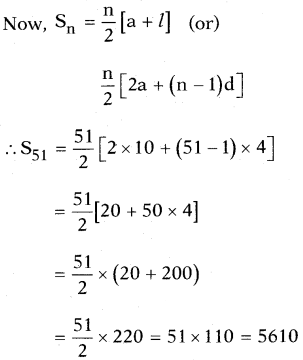
Question 6.
If the sum of first 7 terms of an AP is 49 and that of 17 terms is 289, find the sum of first n terms.
Answer:
Given :
A.P such that S7 = 49; S17= 289
We know that,
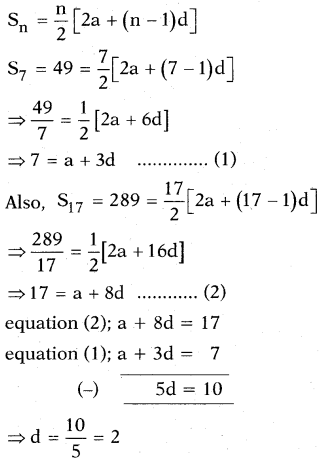
Substituting d = 2 in equation (1), we get,
a + 3 × 2 = 7
⇒ a = 7 - 6 = 1
∴ a = 1; d = 2
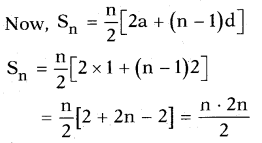
∴ Sum of first n terms Sn= n2.
Shortcut: S7= 49 = 72
S17= 289 = 172
∴ Sn= n2
Question 7.
Show that a1, a2…,an, …. form an AP where anis defined as below:
i) a = 3 + 4n
ii) an= 9 - 5n. Also find the sum of the first 15 terms in each case.
Answer:
Given an= 3 + 4n
Then a1= 3 + 4 × l = 3 + 4 = 7
a2= 3 + 4 × 2 = 3 + 8 = 11
a3= 3 + 4 × 3 = 3 + 12 = 15
a4= 3 + 4 × 4 = 3 + 16 = 19
Now the pattern is 7, 11, 15, ……
where a = a1= 7; a2= 11; a3= 15, ….. and
a2- a1= 11 - 7 = 4;
a3- a2= 15 - 11 = 4;
Here d = 4
Hence a1, a2, ….., an….. forms an A.P.
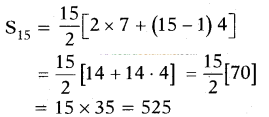
ii) an= 9 - 5n
Given: an= 9 - 5n.
a1= 9 - 5 × l = 9 - 5 = 4
a2= 9 - 5 × 2 = 9 - 10 = -1
a3= 9 - 5 × 3 = 9 - 15 = -6
a4= 9 - 5 × 4 = 9 - 20 = -11
Also
a2- a1= -1 - 4 = -5;
a3- a2= -6 - (-1) = - 6 + 1 = -5
a4- a3= -11 - (-6) = -11 + 6 = -5
∴ d = a2- a1= a3- a2= a4- a3= …. = -5
Thus the difference between any two successive terms is constant (or) starting from the second term, each term is obtained by adding a fixed number ‘-5’ to its preceding term.
Hence {an} forms an A.P.
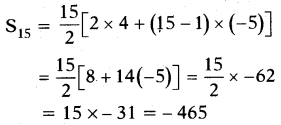
Question 8.
If the sum of the first n terms of an AP is 4n - n2, what is the first term (remember the first term is S1)? What is the sum of first two terms? What is the second term? Similarly, find the 3rd, the 10thand the nthterms.
Answer:
Given an A.P in which Sn= 4n - n2
Taking n = 1 we get
S1= 4 × 1- 12 = 4 - 1 = 3
n = 2; S2= a1+ a2= 4 × 2 - 22= 8 - 4 = 4
n = 3; S3= a1+ a2+ a3= 4 × 3 -32= 12 - 9 = 3
n = 4; S4= a1+ a2+ a3+ a4= 4 × 4 - 42= 16 - 16 = 0
Hence, S1= a1= 3
a2= S2- S1= 4 - 3 = 1
a3= S3- S2= 3 - 4 = -1
a4= S4- S3= 0 - 3 = -3
So, d = a2- a1= l - 3 = -2
Now, a10= a + 9d [∵ an= a + (n - 1) d]
= 3 + 9 × (- 2)
= 3 - 18 = -15
an= 3 + (n - 1) × (-2)
= 3 - 2n + 2
= 5 - 2n
Question 9.
Find the sum of the first 40 positive integers divisible by 6.
Answer:
The given numbers are the first 40 positive multiples of 6
⇒ 6 × 1, 6 × 2, 6 × 3, ….., 6 × 40
⇒ 6, 12, 18, ….. 240
Sn=n/2(a + l)
S40=40/2(6 + 240)
= 20 × 246
= 4920
∴ S40= 4920
Question 10.
A sum of Rs. 700 is to be used to give seven cash prizes to students of a school for their overall academic performance. If each prize is Rs. 20 less than its preceding prize, find the value of each of the prizes.
Answer:
Given:
Total/Sum of all cash prizes = Rs. 700
Each prize differs by Rs. 20
Let the prizes (in ascending order) be x, x + 20, x + 40, x + 60, x + 80, x + 100, x + 120
∴ Sum of the prizes = S7=n/2(a + l)
⇒ 700 =7/2[x + x + 120]
⇒ 700 × 2/7= 2x + 120
⇒ 100 = x + 60
⇒ x = 100 - 60 = 40
∴ The prizes are 160, 140, 120, 100, 80, 60, 40.
Question 11.
In a school, students thought of plant¬ing trees in and around the school to reduce air pollution. It was decided that the number of trees, that each section of each class will plant, will be the same as the class, in which they are studying, e.g., a section of Class I will plant 1 tree, a section of Class II will plant 2 trees and so on till Class XII. There are three sections of each class. How many trees will be planted by the students?
Answer:
Given: Classes: From I to XII
Section: 3 in each class.
∴ Trees planted by each class = 3 × class number

∴ Total trees planted = 3 + 6 + 9 + 12 + …… + 36 is an A.P.
Here, a = 3 and l = 36; n = 12
∴ Sn=n/2(a + l)
S12=12/2[3 + 36]
= 6 × 39
= 234
∴ Total plants = 234
Question 12.
A spiral is made up of successive semicircles, with centres alternately at A and B, starting with centre at A, of radii 0.5 cm, 1.0 cm, 1.5 cm, 2.0 cm, … as shown in figure. What is the total length of such a spiral made up of thirteen
consecutive semicircles? (Take π = 22/7)
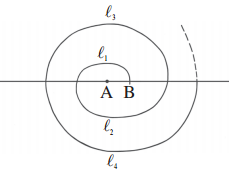
[Hint: Length of successive semicircles is l1, l2, l3, l4,….. with centres at A, B, A, B,…, respectively.]
Answer:
Given: l1, l2, l3, l4,….., l13are the semicircles with centres alternately at A and B; with radii
r1= 0.5 cm [1 × 0.5]
r2= 1.0 cm [2 × 0.5]
r3= 1.5 cm [3 × 0.5]
r4= 2.0 cm [4 × 0.5] [∵ Radii are in A.P. as aj = 0.5 and d = 0.5]
……………………………
r13= 13 × 0.5 = 6.5
Now, the total length of the spiral = l1+ l2+ l3+ l4+ ….. + l13[∵ 13 given]
But circumference of a semi-cirle is πr.
∴ Total length of the spiral = π × 0.5 + π × 1.0 + ………. + π × 6.5
= π ×1/2[l + 2 + 3 + ….. + 13]
[∵ Sum of the first n - natural numbers isn(n+1)/2
=22/7×1/2×13×14/2
= 11 × 13
= 143 cm.
Question 13.
200 logs are stacked in the following manner: 20 logs in the bottom row, 19 in the next row, 18 in the row next to it and so on. In how many rows are the 200 logs placed and how many logs are in the top row?

Answer:
Given: Total logs = 200
Number of logs stacked in the first row = 20
Number of logs stacked in the second row = 19
Number of logs stacked in the third row = 18
The number series is 20, 19, 18,….. is an A.P where a = 20 and
d = a2- a1= 19 - 20 = -1
Also, Sn= 200
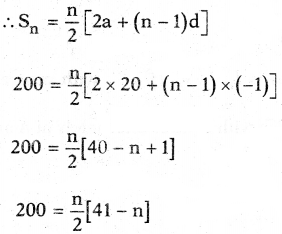
400 = 41n - n2
⇒ n2- 41n + 400 = 0
⇒ n2- 25n - 16n + 400 = 0
⇒ n(n - 25) - 16(n - 25) = 0
⇒ (n - 25) (n - 16) = 0
⇒ n - 25 (or) 16
There can’t be 25 rows as we are starting with 20 logs in the first row.
∴ Number of rows must be 16.
∴ n = 16
Question 14.
In a bucket and ball race, a bucket is placed at the starting point, which is 5 m from the first ball, and the other balls are placed 3 m apart in a straight line. There are ten balls in the line.

A competitor starts from the bucket, picks up the nearest ball, runs back with it, drops it in the bucket, runs back to pick up the next ball, runs to the bucket to drop it in, and she continues in the same way until all the balls are in the bucket. What is the total distance the competitor has to run?
[Hint: To pick up the first ball and the second ball, the total distance (in metres) run by a competitor is 2 × 5 + 2 × (5 + 3)]
Answer:
Given: Balls are placed at an equal distance of 3 m from one another.
Distance of first ball from the bucket = 5 m
Distance of second ball from the bucket = 5 + 3 = 8 m (5 + 1 × 3)
Distance of third ball from the bucket = 8 + 3 = 11 m (5 + 2 × 3)
Distance of fourth ball from the bucket = 11 + 3 = 14 m (5 + 3 × 3)
………………………………
∴ Distance of the tenth ball from the bucket = 5 + 9 × 3 = 5 + 27 = 32 m.
1st ball: Distance covered by the competitor in picking up and dropping it in the bucket = 2 × 5 = 10 m.
2nd ball: Distance covered by the competitor in picking up and dropping it in the bucket = 2 × 8 = 16 m.
3rd ball: Distance covered by the competitor in picking up and dropping it in the bucket = 2 × 11 = 22 m.
………………………………
10th ball: Distance covered by the competitor in picking up and dropping it in the bucket = 2 × 32 = 64 m.
Total distance = 10 m + 16 m + 22 m + …… + 64 m.
Clearly, this is an A.P in which a = 10; d = a2- a1= 16 - 10 = 6 and n = 10.
∴ Sn=n/2[2a + (n - 1)d]
∴ S10=10/2[2 × 10 + (10 - 1)6]
= 5 [20 + 54]
= 5 × 74
= 370 m
∴ Total distance = 370 m.
Question 1.
In which of the following situations, does the list of numbers involved in the form a G.P.?
i) Salary of Sharmila, when her salary is Rs. 5,00,000 for the first year and expected to receive yearly increase of 10% .
Answer:
Given: Sharmila’s yearly salary = Rs. 5,00,000.
Rate of annual increment = 10 %.

Here, a = a1= 5,00,000
a2= 5,00,000 ×11/10= 5,50,000
a3= 5,00,000 ×11/10×11/10= 6,05,000
a4= 5,00,000 ×11/10×11/10×11/10= 6,65,000
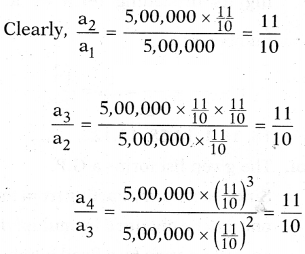
Every term starting from the second can be obtained by multiplying its pre¬ceding term by a fixed number 11/10.
∴ r = common ratio =11/10
Hence the situation forms a G.P.
ii) Number of bricks needed to make each step, if the stair case has total 30 steps. Bottom step needs 100 bricks and each successive step needs 2 bricks less than the previous step.
Answer:
Given: Bricks needed for the bottom step = 100.
Each successive step needs 2 bricks less than the previous step.
∴ Second step from the bottom needs = 100 - 2 = 98 bricks.
Third step from the bottom needs = 98 - 2 = 96 bricks.
Fourth step from the bottom needs = 96 - 2 = 94 bricks.
Here the numbers are 100, 98, 96, 94, ….
Clearly this is an A.P. but not G.P.
iii) Perimeter of the each triangle, when the mid-points of sides of an equilateral triangle whose side is 24 cm are joined to form another triangle, whose mid-points in turn are joined to form still another triangle and the process continues indefinitely.
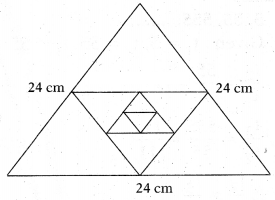
Answer:
Given: An equilateral triangle whose perimeter = 24 cm.
Side of the equilateral triangle =24/3= 8 cm.
[∵ All sides of equilateral are equal] ……. (1)
Now each side of the triangle formed by joining the mid-points of the above triangle in step (1) =8/2= 4 cm
[∵ A line joining the mid-points of any two sides of a triangle is equal to half the third side.]
Similarly, the side of third triangle =4/2= 2 cm
∴ The sides of the triangles so formed are 8 cm, 4 cm, 2 cm,
a = 8
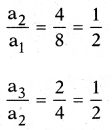
Thus each term starting from the second; can be obtained by multiplying its preceding term by a fixed number 1/2.
∴ The situation forms a G.P.
Question 2.
Write three terms of the G.P. when the first term ‘a’ and the common ratio ‘r’ are given.
i) a = 4 ; r = 3.
Answer:
The terms are a, ar, ar2, ar3, ……..
∴ 4, 4 × 3, 4 × 32, 4 × 32, ……
⇒ 4, 12, 36, 108, ……
ii) a = √5 ; r =1/5
Answer:
The terms are a, ar, ar2, ar3, ……..
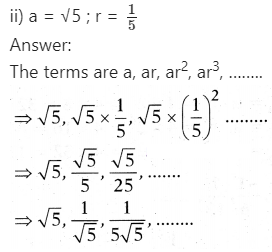
iii) a = 81 ; r = - 1/3
Answer:
The terms of a G.P are:
a, ar, ar2, ar3, ……..

⇒ 81, -27, 9,
iv) a = 1/64; r = 2.
Answer:
Given: a = 1/64; r = 2.
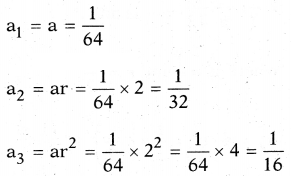
∴ The G.P is 1/64, 1/32, 1/16, ...
Question 3.
Which of the following are G.P. ? If they are G.P, write three more terms,
i) 4, 8, 16, ……
Answer:
Given: 4, 8, 16, ……
where, a1= 4; a2= 8; a3= 16, ……
a2/a1=8/4=2
a3/a2=16/8=2
∴ r =a2/a1=a3/a2= 2
Hence 4, 8, 16, … is a G.P.
where a = 4 and r = 2
a4= a . r3= 4 × 23= 4 × 8 = 32
a5= a . r4= 4 × 24= 4 × 16 = 64
a6= a . r5= 4 × 25= 4 × 32 = 128
ii)1/3, 1/6,1/12, …….
Answer:
Given: t1=1/3, t2= 1/6, t3=1/12, ….
1/3, 1/6,1/12, …….
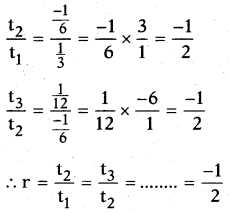
Hence the ratio is common between any two successive terms.
∴1/3, 1/6,1/12, ……. is G.P.
where a =1/3 and r = - 1/2
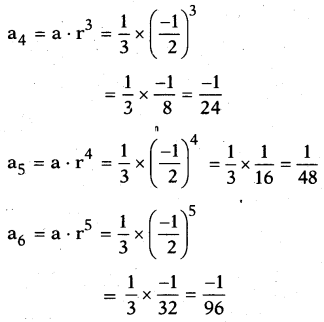
iii) 5, 55, 555, ……..
Answer:
Given: t1= 5, t2= 55, t3= 555, ….
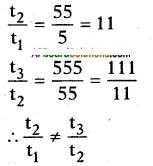
∴ 5, 55, 555, …….. is not a G.P.
iv) -2, -6, -18, ……
Given: t1= -2, t2= -6, t3= -18
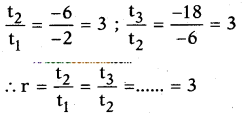
∴ -2, -6, -18, is a G.P.
where a = -2 and r = 3
an= a . rn-1=
a4= a . r3= (-2) × 33= -2 × 27 = -54
a5= a . r4= (-2) × 34= -2 × 81 = -162
a6= a . r5= (-2) × 35= -2 × 243 = -486
v)1/2,1/4,1/6, …….
Answer:

i.e., 1/2, 1/4, 1/6, ….. is not a G.P.
vi) 3, -32, 33, ……
Given: t1= 3, t2= -32, t3= 33, ……
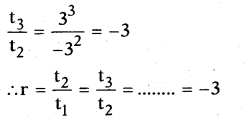
i.e., every term is obtained by multiplying its preceding term by a fixed number -3.
3, -32, 33, …… forms a G.P,
where a = 3; r = -3
an= a . rn-1
a4= a . r3= 3 × (-3)3= 3 × (-27) = -81
a5= a . r4= 3 × (-3)4= 3 × 81 = 243
a6= a . r5= 3 × (-3)5= 3 × (-243) = -729
vii) x, 1, 1/x, …….
Answer:
Given: t1 = x, t2 = 1, t3 = 1/x, ..
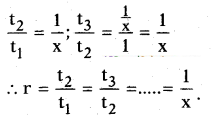
Hence x, 1, 1/x, ……. forms a G.P.
where a = x; r = 1/x
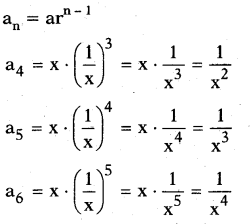
viii) 1/√2, -2, 8/√2, ...
Answer:
Given: t1 = 1/√2, t2 = -2, t3 = 8/√2, ..
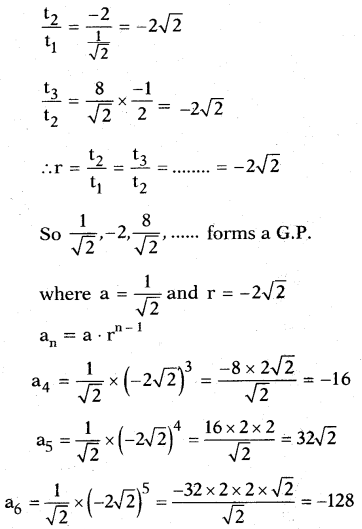
ix) 0.4, 0.04, 0.004, ……..
Answer:
Given: t1= 0.4, t2= 0.04, t3= 0.004, ……
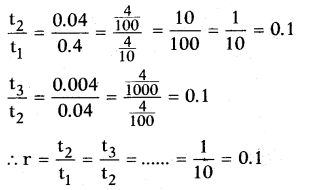
∴ 0.4, 0.04, 0.004, …….. forms a G.P.
where a = 0.4; r =1/10
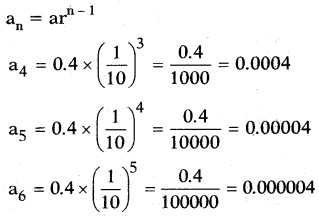
Question 4.
Find x so that x, x + 2, x + 6 are consecutive terms of a geometric progression.
Answer:
Given x, x + 2 and x + 6 are in G.P. but read it as x, x + 2 and x + 6.
∴ r =t2/t1=t3/t2
⇒x+2/x=x+6/x+2
⇒(x + 2)2= x(x + 6)
⇒ x2+ 4x + 4 = x2+ 6x
⇒ 4x - 6x = - 4 = -2x = -4
∴ x = 2
Question 1.
For each geometric progression find the common ratio ‘r’, and then find an.
i) 3, 3/2, 3/4, 3/8, …….
Answer:
Given G.P.: 3, 3/2, 3/4, 3/8, …….
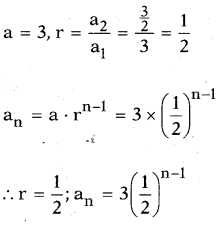
ii) 2, -6, 18, -54, …….
Answer:
Given G.P. = 2, -6, 18, -54, …….
a = 2, r = a2/a1 = -6/2 = -3
an= a . rn-1= 2 × (-3)n-1
∴ r = -3; an= 2(-3)n-1
iii) -1, -3, -9, -27, …….
Given G.P. = -1, -3, -9, -27, …….
a = -1, r = a2/a1 = -3/-1 = 3
an = a . rn-1 = (-1) × 3n-1
∴ r = 3; an = (-1) × 3n-1
iv) 5, 2, 45, 825, …….
Given G.P. = 5, 2, 45, 825, …….
a = 5, r = a2/a1 = 25
an = a . rn-1 = 5 × (2/5)n-1
∴ r = 25; an = 5(2/5)n-1
Question 2.
Find the 10th and nth term of G.P.: 5, 25, 125,...
Answer:
Given G.P.: 5, 25, 125,...
a = 5, r = a2/a1 = 25/5 = 5
an = a . rn-1 = 5 × (5)n-1 = 51+n-1 = 5n
a10= a . r9= 5 × 59= 510
∴ a10= 510; an= 5n
Question 3.
Find the indicated term of each geometric progression.
i) a1 = 9; r = 1/3; find a7.
Answer:
an = a . rn-1
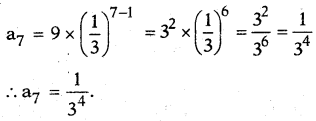
ii) a1= -12; r =1/3; find a6.
Answer:
an= a . rn-1
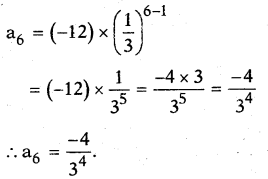
Question 4.
Which term of the G.P.
i) 2, 8, 32,….. is 512?
Answer:
Given G.P.: 2, 8, 32,….. is 512
a = 2, r = a2/a1 = 8/2 = 4
Let the nthterm of G.P. be 512
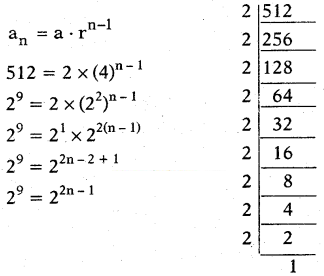
512 = 2 × 2 × 2 × 2 × 2 × 2 × 2 × 2 × 2
= 29
∴ 2n - 1 = 9
[∵ bases are equal, exponents are also equal]
∴ 2n = 9 + 1 = 10
n = 10/2 = 5
∴ 512 is the 5thterm of the given G.P.
ii) √3, 3, 3√3, …….. is 729?
Answer:
Given G.P.: √3, 3, 3√3, …….. is 729
a = √3, r = a2/a1 = 3/√3= √3
now an= a . rn-1= 729
⇒ (√3)(√3)n-1= 729
⇒ (√3)n= 36= (√3)12
⇒ n = 12
So 12th term of GP √3, 3, 3√3, …….. is 729.
iii) 1/3, 1/9, 1/27, ... is 1/2187?
Answer:
Given G.P.: 1/3, 1/9, 1/27, ... is 1/2187

Let 1/2187 be the nth term of the G.P., then
an = a . rn-1 = 1/2187

[∵ bases are equal, exponents are also equal]
7th term of G.P is 1/2187.
Question 5.
Find the 12th term of a G.P. whose 8 term is 192 and the common ratio is 2.
Answer:
Given a G.P. such that a8= 192 and r = 2
an= a . rn-1
a8= a . (2)8-1= 192
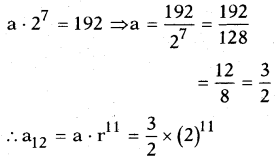
= 3 × 210= 3 × 1024 = 3072.
Question 6.
The 4thterm of a geometric progression is 2/3 and the seventh term is 16/81. Find the geometric series.
Answer:
Given: In a G.P.
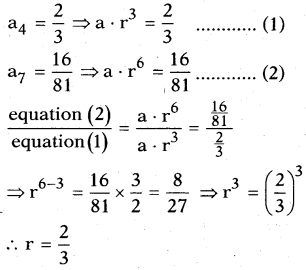
Now substituting r = 2/3 in equation (1)
we get,
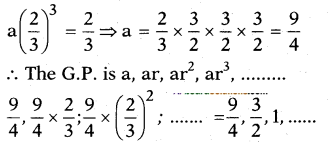
Question 7.
If the geometric progressions 162, 54, 18, ….. and 2/81, 2/27 , 2/9,….. have their nthterm equal, find the value of n.
Answer:
Given G.P.: 162, 54, 18, ….. and 2/81, 2/27 , 2/9,……
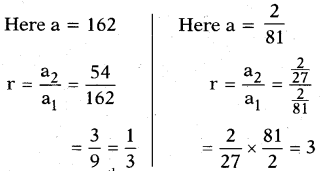
Given that nth terms are equal
an = a . rn-1
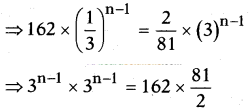
⇒ 3n-1+n-1= 81 × 81
⇒ 32n-2= 34 × 34
⇒ 32n-2= 38[∵ am. an= am+n]
⇒ 2n - 2 = 8
[∵ bases are equal, exponents are also equal]
2n = 8 + 2
⇒ n =102= 5
The 5thterms of the two G.P.s are equal.